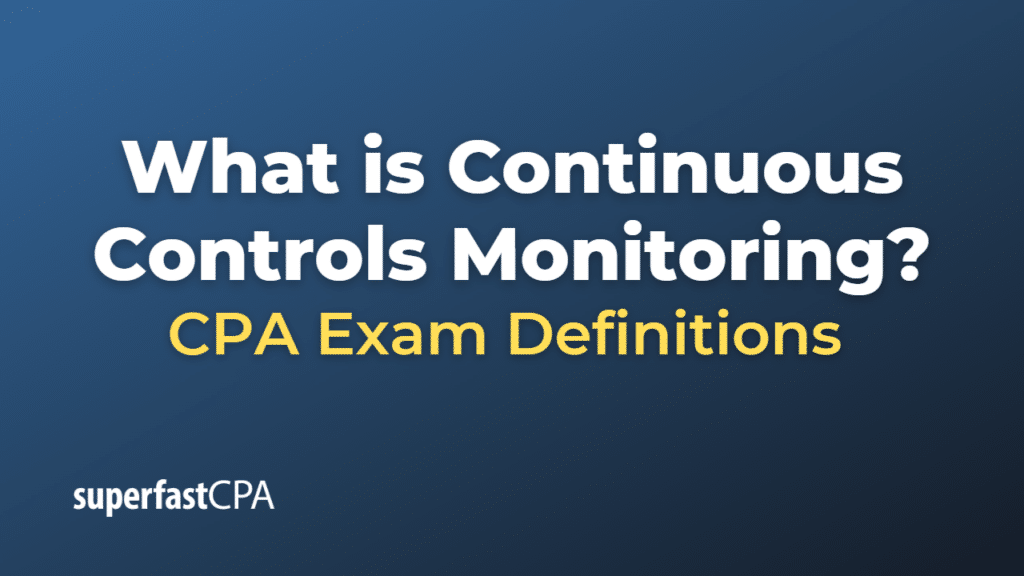Continuous Controls Monitoring
Continuous Controls Monitoring (CCM) is a proactive approach to assessing and evaluating the effectiveness of internal controls within an organization on an ongoing basis. It involves the use of technology and automated tools to regularly monitor and test key controls, processes, and transactions to identify potential weaknesses, non-compliance, or instances of fraud. CCM is typically integrated into an organization’s risk management, internal audit, and compliance functions.
The primary objectives of Continuous Controls Monitoring are:
- Improve the effectiveness of internal controls: By continuously monitoring and testing controls, organizations can identify and address weaknesses or gaps in their control environment more quickly, leading to improved control effectiveness and reduced risk exposure.
- Enhance compliance: CCM helps organizations maintain compliance with relevant laws, regulations, and internal policies by identifying potential compliance issues early and enabling prompt corrective action.
- Increase efficiency: Automated CCM processes can reduce the manual effort and resources required for traditional control testing and monitoring, allowing organizations to allocate resources more efficiently.
- Strengthen risk management: By providing real-time visibility into the organization’s control environment, CCM enables organizations to make more informed risk management decisions and prioritize their risk mitigation efforts.
- Facilitate early detection and remediation: Continuous Controls Monitoring allows organizations to identify and address control issues, non-compliance, or potential fraud more quickly, minimizing the potential financial, operational, and reputational impacts.
- Support internal audit activities: CCM can provide valuable insights and data to support the internal audit function, helping to focus audit efforts on high-risk areas and streamline audit planning and execution.
Examples of Continuous Controls Monitoring activities include:
- Monitoring access controls to sensitive data or systems to ensure that only authorized users have access
- Analyzing transaction data for unusual patterns or trends that could indicate fraud or errors
- Verifying compliance with segregation of duties policies to prevent unauthorized actions or conflicts of interest
- Tracking key performance indicators (KPIs) related to control effectiveness and efficiency
Implementing a successful CCM program typically involves a combination of technology solutions, such as data analytics tools, specialized control monitoring software, and integration with existing systems and processes. Organizations also need to establish clear roles and responsibilities, define monitoring objectives and criteria, and develop a process for reporting and addressing identified control issues.
Example of Continuous Controls Monitoring
Let’s consider a fictional example of a manufacturing company called “MegaManufacture” that implements Continuous Controls Monitoring (CCM) to strengthen its internal control environment, improve compliance, and enhance risk management.
MegaManufacture has identified several critical control areas where continuous monitoring could provide significant benefits, including:
- Procurement and accounts payable: MegaManufacture implements CCM to monitor procurement activities and accounts payable transactions for potential duplicate payments, unauthorized transactions, and compliance with purchasing policies and procedures. The CCM system analyzes transaction data to identify patterns or trends that could indicate fraud or errors, such as unusually high invoice amounts, frequent changes to vendor bank account details, or transactions with vendors not on the approved supplier list.
- Inventory management: MegaManufacture uses CCM to track inventory levels, movements, and adjustments in real-time, helping to identify potential issues such as stock discrepancies, obsolete or slow-moving items, and unauthorized inventory transactions. The CCM system also verifies compliance with established inventory control policies and procedures, such as segregation of duties and periodic inventory counts.
- Access controls and system security: MegaManufacture implements CCM to monitor access to sensitive data and systems, ensuring that only authorized users have access and that access privileges are in line with job responsibilities. The CCM system also tracks failed login attempts, unauthorized system changes, and other potential security incidents.
- Regulatory compliance: MegaManufacture is subject to various industry regulations and must comply with environmental, health, and safety standards. The company uses CCM to monitor compliance with these requirements by tracking key performance indicators (KPIs), such as emission levels, workplace accident rates, and employee training records.
By implementing Continuous Controls Monitoring, MegaManufacture can proactively identify and address control weaknesses, compliance issues, and potential fraud, resulting in a stronger control environment, improved risk management, and more efficient use of resources. Additionally, the CCM program supports the company’s internal audit function by providing valuable insights and data to focus audit efforts on high-risk areas and streamline audit planning and execution.













